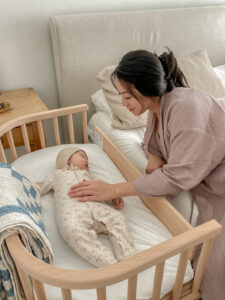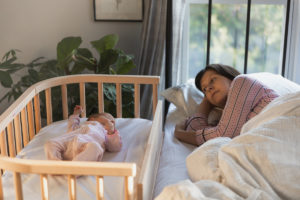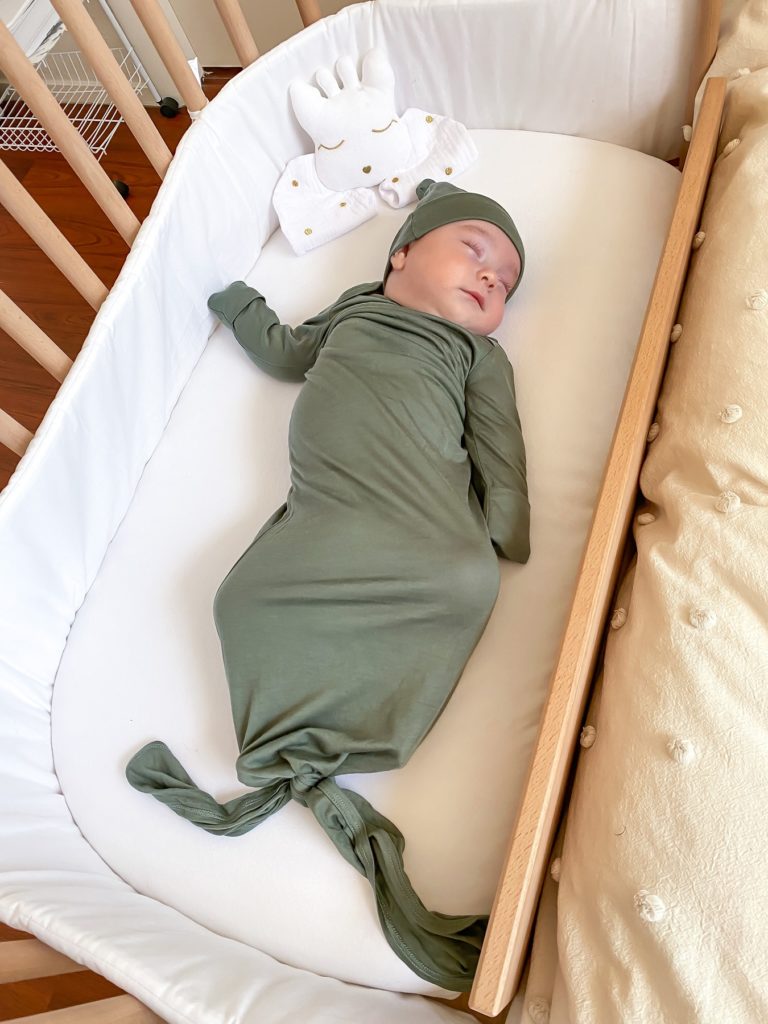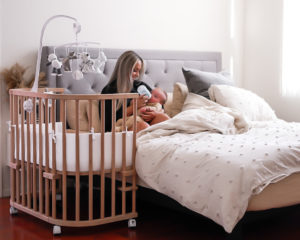what is co sleeping
So what is co-sleeping?
You could be a preparing parent-to-be. Or you could be a parent pregnant with their second baby, wanting a sleep solution that gives you more — and better — nights of sleep than you got with your first. Or you could have just heard about co-sleeping on the playground and be sitting on this page wondering what all the hype is about.
No matter what made you want to discover more about one of the most time-loved sleep practices out there, one thing is true: you’re not the first person to wonder whether co-sleeping offers parents and baby a more peaceful, health-promoting way to sleep. 
In countries like Sweden and Japan, co-sleeping is the norm. One study found that 72% of Swedish families co-sleep with their children, while mothers in Guatemala have been known to respond with disbelief — and also concern — when told that some babies around the world sleep without their parent by their side.
Where a child sleeps has long been a conversation in the United States, especially as early versions of the modern-day cribs were invented (and became popularized) throughout the 1600s-1800s.
But families are increasingly celebrating co-sleeping as a practice that fosters the healthy independence, healthy emotional regulation, and healthy physical development of newborn babies.
We’re about to break down the what, why, and how of co-sleeping: while giving you all the inside insights you need to know whether the world-loved and time-honored practice of co-sleeping is right for you and your family.
Let’s Start with the Basics: What is Co-Sleeping?
“Co-sleeping” is often used as a catch-all term to describe the experience of sleeping with your baby close by. But in reality, co-sleeping may look a little different for every family.
When you think of the word “co-sleep,” you might get an image of a family cuddled up close to each other all night long: sharing a bed as well as sharing a sleep space.
However, this is only one version of what co-sleeping can look like. 
Parents may lay their child in a safe bedside sleeper that attaches to the side of their own bed. Or they might invite their baby to share a bed with them, while staying nestled up to them all night long. Or they might share a bedroom with their child, while encouraging their baby to sleep in a separate crib space. (This kind of sleep practice is more often — and more accurately — referred to as “room sharing”).
All of these can be considered versions of co-sleeping.
What the American Academy of Pediatrics has to say:
The American Academy of Pediatrics (AAP) recommends that all parents sleep in the same room with their baby (or “room share”) through at least the 6-month mark, but ideally through the first year.
When this “room sharing” recommendation from the AAP is paired with a safe sleep tool like a bedside co-sleeper, it easily starts to fall into the c0-sleeping category as well.
With safe sleep tools like bedside sleepers, parents are able to sleep with their newborn baby only an arm’s reach away (making nighttime nursing a breeze). While still giving their little one a safe sleep space that has been designed to perfectly support their health and comfort.
When Did Co-Sleeping Become a Thing?
Though parents in many modern Western countries have popularized separate bedrooms and detached cribs, for thousands of years parents have been going to sleep with their newborn baby curled up close to their side. 
In fact, parents from many different cultures have long understood that co-sleeping promotes healthy emotional and physical development while bonding you and your baby, easing the stress of nighttime nursing, and gifting everyone in the house a more restful night of rest.
But as soon as mattresses and cribs became the new in-trend home fashion statement of the 19th century, parents in the Western world increasingly kicked children out of their own beds and moved them into mattresses and rooms of their own. In America, Canada, and Europe, some parents continue to move children out of their own bedroom and encourage them to sleep through the night alone.
However, anthropologist John Whiting surveyed 186 cultures and found that solitary sleeping might be a Western trend, but it’s far from a universal norm. He discovered that almost 70% of children living and growing around the world sleep in the company of others.
Whiting’s research shows that co-sleeping isn’t just a trend — it’s the most popular and longest-loved sleeping practice in history.
Co-Sleeping Benefits: What Parents Love About the Sleep Practice
When it comes to co-sleeping benefits, there are some that support your body, some that support your mind, and some that are fully focused on helping your baby develop healthily.
Research has shown that parents remain physiologically connected their baby long after they’ve given birth.
Co-sleeping builds off this connection by setting parent and child in the close proximity they need to become responsive to breathing patterns and uniquely attuned to wakefulness.
Experts have also discovered that this kind of night-time close contact leads to a host of other benefits for baby, by helping them:
- Stabilize their body temperature
- Breathe more regularly (partly by matching their breathing patterns to their parents)
- Use energy more efficiently
- Grow more quickly
- Feel more calm and experience fewer moments of heightened stress
Close night-time sleeping also helps mothers (especially those who are getting used to getting sleep after c-section) by making it easy to nighttime nurse without getting out of bed, or offer comfort without continuously needing to reach over crib bars.
But How Does Co-Sleeping Deliver All These Benefits?
To grow healthily in body and mind, your baby needs to be able to receive — and respond to — a ton of sensory feedback. When babies are shut alone in their room at night, they lose the opportunity to grow their sensory awareness during their sleeping hours.
But when babies are able to sleep close to others, they learn to bond and build meaningful connections while learning, growing, and developing an ability to separate and identify different sensory input.
This helps them breathe more regularly, while experiencing less stress overall by learning what it feels like to be safe, secure, and protected.
(And that’s good news—because when babies are less stressed, they put more energy into healthy growth and reap the rewards of a healthier immune system!)
Before We Go: What Is the Difference Between Co-Sleeping and Bed Sharing?
Many parents who start to explore co-sleeping will find another term pop up in their suggested searches: bed sharing.
Bed sharing is just as it sounds — it’s the practice of inviting your newborn not just into your bedroom, but onto your mattress as well. 
Though bed sharing may boast some of the same benefits as other forms of co-sleeping — including increased bonding between parents and child and a less stressful night’s sleep for all — it is also sometimes seen to be less safe.
The feather-topped, super-soft, oh-so-pillowy mattresses that most of the Western world prefers can’t properly support your baby throughout the night. According to the American Academy of Pediatrics, your baby needs firmness and stability under their body while they sleep to ensure their body’s healthy growth.
Though baby will love having you nearby as they rest, they won’t necessarily love your sleeping surface. Nor will they love all the extra blankets, pillows, and other comfort materials that adults love to surround themselves with as they sleep.
As comfy as it might be for adults to tuck into a long night surrounded by a cloud of goose down, those comfort items can easily get wrapped around your baby throughout the night and lead to unsafe situations. 
That’s why parents should — and do — choose safe sleep for babies when setting up their environment.
How Do You Promote Safe Sleep For Your Little One While Co-Sleeping?
By choosing a bedside sleeper that fits flush against their bed, parents like you can control the specifics of their baby’s environment. (The first step? Pick a bedside co sleeper that’s right for baby and right for your room!)
Your baby can sleep securely nestled within an arm’s reach of you, while feeling comforted and protected on a mattress that is firm enough to support them and ensure safe sleeping.
They can receive, learn, and grow from all the sensory input they receive throughout the night — while you sleep soundly knowing that they are safe in a bedside sleeper built just for them.
Is co-sleeping bad? There’s a lot of conversation about co-sleeping out there. Whether you’re welcoming your first baby to the world or have a family of 5 or 6 already, you’ve probably heard about co-sleeping. And maybe even popped “about co-sleeping” into Google a time or two.
So why all the hype about co-sleeping? Co-sleeping has long been the preferred (and safe, as long as you choose the right method!) way for families around the world to assure that their babies are getting nurturing rest. Before there were beds or mattresses or even cribs, families would gather close together and nestle into a state of happy sleep while lying within arm’s reach.
When the earliest cribs starting coming onto the scene around the 1600s, the hype for co-sleeping didn’t die down. But within the co-sleeping conversation, there’s one important thing to note. Co-sleeping with the help of a safe sleep tool like a bedside co-sleeper is not the same thing as bed-sharing (which is better understood as the practice of inviting your baby to share your own mattress).
That’s why asking “Is co-sleeping bad?” is too simple. But we’re about to set the co-sleeping record straight on all that…
We’re about to break down:
- The back-to-the-basics details about what co-sleeping is and how it became the most common method of sleep around the world
- The benefits that co-sleeping families enjoy, as well as the way families get more rest just by sleeping close to their little one
- How co-sleeping has looked throughout history, and why that matters for sleep deprived parents trying to get more rest now
- Where things really stand in this whole “Is c0-sleeping bad?” question, and what co-sleeping families wish more people talked about

The Best Place to Start Is at the Beginning: What is Co-Sleeping?
Co-sleeping is often the catch-all term used to describe the nurturing experience of sleeping with your baby within arm’s reach.
Though the word “co-sleeping” often brings up images of parent and baby sleeping together in the same bed and sharing the same sleep space, the truth is that there are many ways to co-sleep, and each nighttime routine will look a little different for every family.
In recent years, tools like bedside co-sleepers have made it safe, easy, and stress-free to soak in all the benefits of co-sleeping by giving babies a made-just-for-them place to rest their head and get quality sleep through the night.
These methods aren’t only proven-safe through experience, they’re also backed by some of the strictest safety certification standards on the market, with organizations like ASTM International, TÜV Rheinland, and Confidence in Textiles giving bedside co-sleepers like babybay a full stamp of approval.
And though sleeping in separate bedrooms has become the norm in the Western world (which is the leading thing that causes some parents to wonder whether alternatives like co-sleeping are really the best way to go), that doesn’t mean it’s not the preferred bonding-promoting and safety-assuring method of rest across much of the globe.
In fact, studies (like one famously conducted by anthropologist John Whiting) have found that almost 70% of children living around the world sleep in the company of others. (Take a moment to really let those numbers sink in— 70%!)
Benefits of Co-Sleeping: A Quick But Thorough Overview
Through the act of co-sleeping, you and your baby are able to bond and become close-as-can-be during both your waking and sleeping hours. (Hard to believe, but our sleeping hours account for a third of our day — which is why it’s so important to make them count!)
Your baby also benefits from a boosted immune system and better-supported development for their body and mind, which not only benefits their waking hours but leads to more restful time spent in dreamland as well.
Co-sleeping also makes nighttime nursing a breeze by keeping your baby easily within arm’s reach, so that you don’t have to take walks back and forth across the room or repeatedly over crib bars to give your child what they need.
At the end of the day, it shouldn’t really be surprising that there are numerous benefits of co-sleeping. Human biology naturally encourages child and parent to seek contact during the night.
And while you might think that it’s simply love for your child that has you craving a quick hug, kiss, or loving touch during all hours of the day and night (love is definitely part of it, we promise!), that mutual craving for contact is also just built into our physiology.
While that need for nighttime contact through the night isn’t much-talked about in the United States, it’s something that many other cultures around the world understand well.
In Japan, for instance, the most common sleeping position is referred to as kawa no ji (represented by the character for river: 川). The two longer lines in that character represent the parents, while the shorter one represents the child sleeping between — showcasing the close proximity and sleep-together care that goes into nighttime sleep setups.
But in America and other Western cultures, history has set a trend of separating parents and babies during the night.
That’s not because separating parents and babies is better — we’ve just gotten so used to sleeping separately that it’s hard to imagine that another way of sleeping could be more beneficial.
Co-Sleeping Throughout History: Why the Question “What Is Co-Sleeping” Only Started Needing to Be Asked Recently
The Western world’s interest in sleeping separately can partly be traced back to the 19th century, when it became fashionable to show your wealth by building houses with extra bedrooms and filling those extra bedrooms with plush mattresses and beautiful cribs.
Though collecting mattresses is no longer the in-trend fashion statement it used to be, most families in the Western world continue to encourage their children to sleep in separate rooms.
And while there’s nothing wrong with preferring for your child to sleep in a space separate from yours, over time this became seen as the standard way to sleep in the Western world — which quickly made all other sleeping methods seem like unideal alternatives (even if they did, in fact, actually come with a whole host of rest-giving and mind-balancing benefits).
So Let’s Sum It All Up: Is Co-Sleeping Bad?
When co-sleeping is practiced safely, it delivers a bounty of benefits while helping you feel closer to your child (emotionally and physically!) all night long. 
But just like you have to make decisions with safety in mind when preparing a nursery or separate room for your child to sleep in, you need to make safety a priority when deciding the co-sleeping method that works for your family.
But if you aren’t sure where to start, start here: bedside infant co-sleepers make safe co-sleeping easy as can be by gifting baby with a safe, secure, and supported space to sleep by your side.
Your baby gets to drift off into sweet dreams with you within arm’s reach, while you get to enjoy the worry-free rest that comes from knowing you can quickly and easily respond to any nighttime feeding call that comes throughout the night.
And while there may be other ways of co-sleeping out there, there’s only one safe co-sleeping method we can recommend.
With the right bedside sleeper by your side, you’ll never have to wonder Is co-sleeping bad? again. You’ll be able to confidently drift toward dreamland, knowing your baby is safe, happy, and soaking in all the benefits that co-sleeping has to offer.


